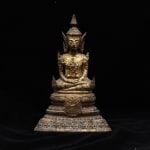Late Ayutthaya Buddha, 18th Century CE
Gilt bronze
height 19 cm
height 7 1/2 in
height 7 1/2 in
AB.001
Further images
-
(View a larger image of thumbnail 1
)

-
(View a larger image of thumbnail 2
)

-
(View a larger image of thumbnail 3
)

-
(View a larger image of thumbnail 4
)

-
(View a larger image of thumbnail 5
)

-
(View a larger image of thumbnail 6
)

-
(View a larger image of thumbnail 7
)

-
(View a larger image of thumbnail 8
)

-
(View a larger image of thumbnail 9
)

This elaborately decorated sculpture shows the Buddha seated in a half-lotus position, with his right foot resting on his left knee. He is seated on a three-layered platform, each layer...
This elaborately decorated sculpture shows the Buddha seated in a half-lotus position, with his right foot resting on his left knee. He is seated on a three-layered platform, each layer wider than the one above, with an elegant hanging attached to the uppermost layer. Pointed spikes protrude from his knees and shoulders, mirroring the shape of his extended ears and the conical ushnisha projecting from the top of his tightly curled hair. The ushnisha is a protuberance on the top of the head which is one of the Buddha’s key characteristics and which symbolises his enlightenment. The repeated pointed motif, as well as the triangular shape created by the platform, give this sculpture a sense of elegant symmetry. As well as extending upwards, the figure’s ears are also lengthened at the bottom and curve backwards to form a detailed spiral. Within East Asian belief, particularly Buddhism, large ears are seen as a sign of wisdom and compassion. The Buddha is often depicted with elongated ears to symbolise his ability to hear the cries of those who are suffering, and his sympathy and willingness to help ease their pain. It is therefore a comforting image, as it reminds those who see it that there is hope for an end to their sufferings through the search for enlightenment and the compassion of those who have reached it. The gesture which the Buddha is forming with his hands is known as the Dhyana mudra, and is associated with meditation. This, in combination with his peaceful expression, is a reminder that he was able to achieve nirvana through focused spiritual practice.
Ayutthaya period images, created in Thailand between the 10th and 18th centuries, often depict the Buddha dressed in royal clothing, contrasting with other depictions of the Buddha which choose to portray him wearing very simple clothing, showing that he has given up the desire for worldly possessions. It is also common in Ayutthaya period images to show the Buddha sitting on a highly decorated base, as can be seen in this example.
Ayutthaya period images, created in Thailand between the 10th and 18th centuries, often depict the Buddha dressed in royal clothing, contrasting with other depictions of the Buddha which choose to portray him wearing very simple clothing, showing that he has given up the desire for worldly possessions. It is also common in Ayutthaya period images to show the Buddha sitting on a highly decorated base, as can be seen in this example.








